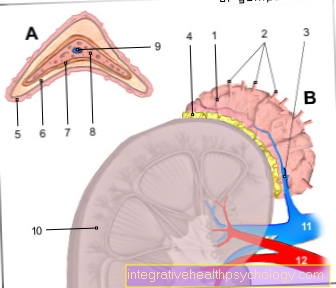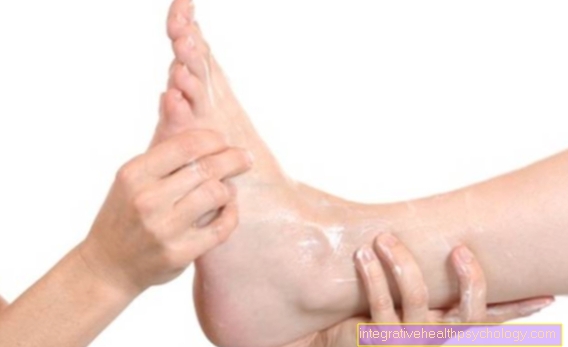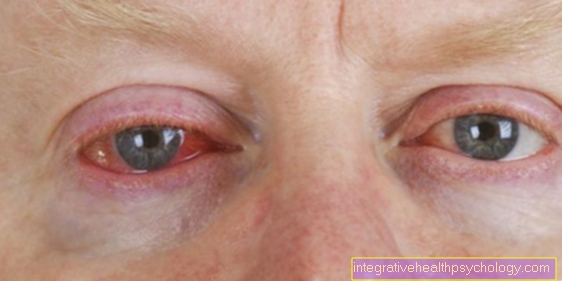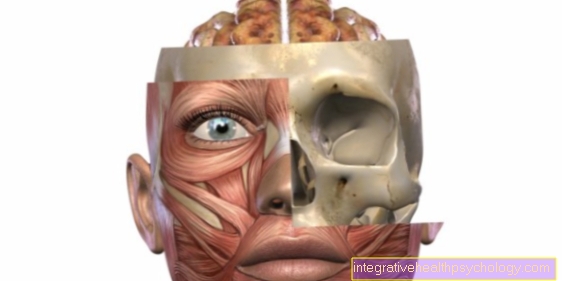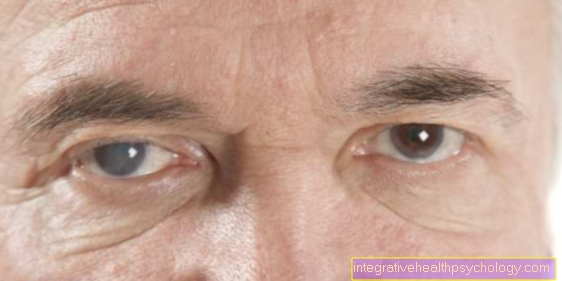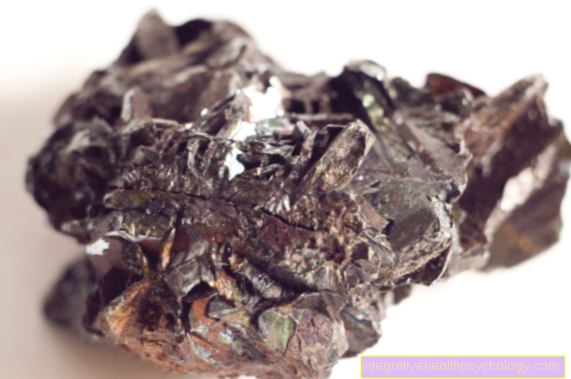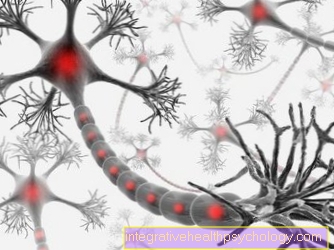Vitreous opacity
introduction
Almost everyone, when looking at a white wall, at the sky or at white paper, can see small black dots, fluff or threads that other people cannot see. These spots in the field of vision move scurrying along with the line of sight. They are known as "flying mosquitoes" (Mouches floaters). They are caused by opacities in the vitreous humor.
Depending on the degree of impairment, a classification or a classification according to severity is carried out, but there is no uniform categorization of vitreous opacities. At the beginning of life, the vitreous is a homogeneous mass, which in the course of life is increasingly interspersed with fibrous parts or fluid-filled cavities. These fibrous parts result from the condensation of the macromolecules on the collagen fibers in a physiological way. The water previously bound to the molecules is released and the glass body liquefies. In the course of this change, the vitreous shrinks and separates from the retina in the rear area. The fibrous parts are distributed freely in the eye and when there is particularly high light irradiation they cast shadows on the retina, the "black spots" already mentioned.
The points and streaks that are perceived are therefore not an illusion. Mouches floaters are especially severe when the irregularities are close to the retina. If the destruction of the vitreous is already well advanced, the opacities can be perceived against any background and even with closed eyes.

The vitreous
The vitreous body in the eye is responsible for keeping the eye in its shape. The gel-like, transparent mass lies between the lens of the eye and the Retinawhich is why the light has to cross the vitreous humor to reach the retina. The vitreous body consists mainly of water (98%), Collagen fibers and from Hyaluronic acid (2%). The latter is responsible for the gel-like consistency and transparency of the vitreous due to its water-binding property.
Detecting vitreous opacity
What are the symptoms of vitreous opacity?
Two thirds of the 65 to 85 year olds complain about the occurrence of "flying flies". Even severely short-sighted young people can be affected by these symptoms, as their vitreous humor is longer. The "Mouches volant" are mostly harmless and do not restrict eyesight.
However, the patient's subjective visual perception is limited and the symptoms associated with the vitreous opacity are perceived as annoying. However, the less attention one pays to the apparitions, the less they will be seen. The disease value is therefore mainly determined by the severity, the location of the spots in the central field of vision and the proximity to the retina. In addition, the mobility of the opacities and the subjective impairment are criteria for the disease value.
If symptoms begin (initial perception of the spots), an ophthalmologist should be consulted who can rule out pathological causes. Furthermore, from the age of forty, the eyes should be checked annually by an ophthalmologist so that pathological processes can be recognized and stopped at an early stage. Particular caution and clarification is advised if the cloudiness appears in dense swarms or flashes of light, because then a retinal tear could have occurred and a retinal detachment threatened. Stronger symptoms, which are perceived as "soot rain", can be caused by bleeding into the vitreous humor caused by detachment of the retina, diabetes mellitus or metabolic diseases. In general, there is no need to worry if the symptoms are mild, as they are harmless and simply the result of an age-related degeneration process.
Also read: Vitreous detachment
How is vitreous opacity diagnosed?
At the first symptoms, a doctor should be consulted to clarify the cause. It could be a harmless vitreous cloudiness or a more serious condition. In order to make this differential diagnosis, it is first important that the ophthalmologist takes a detailed anamnesis (questions about the medical history).
Questions about shape, first appearance, first perception of the black spots are asked. After the detailed "questioning", the doctor will examine the eye more closely. First of all, the patient is given eye drops which initially weaken the eyesight for a few hours. The drops dilate the pupils. The doctor shines into the eye with a so-called slit lamp. With his magnifying glass he can assess the individual parts of the eye.
If the vitreous is cloudy, the doctor will recognize dark shadows. If the examination with the slit lamp is not clear, other examination methods can also be considered. An ultrasound examination is used to clarify a retinal detachment. Examinations such as x-rays, computed tomography or magnetic resonance tomography clarify whether a foreign body in the eye triggers the symptoms of vitreous opacity.
Treating vitreous opacity
How is vitreous opacity treated?
As a rule, no treatment measures are necessary after the diagnosis of vitreous opacity.
There are a few things that the patient can do by themselves to improve the symptoms of black spots. Sunglasses with a high level of light protection prevent the symptoms from being aggravated by exposure to the sun. For the same reason, self-tinting glasses are recommended for myopic patients. The brightness should be reduced when electronic devices are used intensively in order to make working on them as pleasant as possible.
A healthy diet and plenty of water can strengthen the eyes. In addition, certain vitamins and phytonutrients (Vitrocap), which can be taken as capsules, help to meet the increased need for micronutrients. Healthy eating and daily exercise not only strengthen the entire body, but also help you lose weight. This is important because overweight is described in the specialist literature as an influencing factor on vitreous opacity.
In addition, you should strengthen your eyes by using eye drops to prevent irritated or dry eyes. A final option for treating vitreous opacity is surgical removal of the vitreous, the so-called vitrectomy. However, this operation should be avoided in any case and only carried out in the most extreme cases. An extreme case is used when the patient is in pain and notices flashes of light. Only in a very few cases is there no other option than surgical removal of the vitreous humor. The procedure is usually carried out under local anesthesia. Large parts of the vitreous are removed by suction, removing the particles that lead to the image of the flying flies.The removed part of the vitreous is filled with silicone oil, gas or a saline solution to remove the vitreous. In general, surgical removal of the vitreous body involves fewer surgical risks thanks to precise technology, and minimal access to the operating area means that sutures are no longer necessary, as the openings close by themselves.
Nonetheless, this procedure carries some risks: most patients develop severe cataracts one to two years after the operation, which must be operated again. Here, especially in young patients, a precise risk-benefit assessment must be made. Another option is laser treatment, which is less risky than surgical removal of the vitreous humor. The vitreous body is irradiated with a laser in several sessions in order to destroy the lumps contained in the vitreous body. This process is known as photodisruption. Laser treatment is a technically difficult process that ultimately does not guarantee the complete elimination of the interfering particles. Usually carried out on an outpatient basis in the practice, the eyes are anesthetized with eye drops. The patient looks through a contact lens that is connected to the laser, while the doctor adjusts the setting of the laser and determines the irradiation location with a microscope. The application of the laser takes between 30 and 60 minutes and then anti-inflammatory eye drops are applied.
Preventing vitreous opacity
What are the causes of vitreous opacity?
Most of the time, the vitreous opacity is due to an age-related process. However, there are also pathological opacities of the vitreous body, such as the asteroid hyalosis, in which the opacities are caused by white deposits and usually only occur in one eye. In addition, the opacities in the clinical picture are Asteroid hyalosis immobile and firmly associated with the framework of the vitreous humor. It is believed that this form of vitreous opacity is caused by poorly controlled diabetes mellitus.
Vitreous opacities also rarely occur after eye injuries or inflammations. An extensive medical history and examination must be carried out before each treatment.
Course of vitreous opacity
What is the prognosis for vitreous opacity?
If the black spots appear for the first time, an ophthalmologist needs to be seen urgently. This then determines whether the vitreous body is unproblematic or whether it is another disease. Usually, vitreous opacity does not require further treatment and the patient's symptoms subside on their own. After several months to years, the flying mosquitoes may decrease or even disappear completely.


